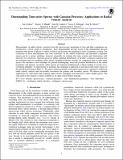Files in this item
Disentangling time-series spectra with Gaussian processes : applications to radial velocity analysis
Item metadata
| dc.contributor.author | Czekala, Ian | |
| dc.contributor.author | Mandel, Kaisey S. | |
| dc.contributor.author | Andrews, Sean M. | |
| dc.contributor.author | Dittmann, Jason A. | |
| dc.contributor.author | Ghosh, Sujit K. | |
| dc.contributor.author | Montet, Benjamin T. | |
| dc.contributor.author | Newton, Elisabeth R. | |
| dc.date.accessioned | 2023-09-01T14:30:14Z | |
| dc.date.available | 2023-09-01T14:30:14Z | |
| dc.date.issued | 2017-05-04 | |
| dc.identifier | 293202658 | |
| dc.identifier | fb930e9c-fb09-409b-bf57-6c6dfd0c910a | |
| dc.identifier | 85019151544 | |
| dc.identifier.citation | Czekala , I , Mandel , K S , Andrews , S M , Dittmann , J A , Ghosh , S K , Montet , B T & Newton , E R 2017 , ' Disentangling time-series spectra with Gaussian processes : applications to radial velocity analysis ' , The Astrophysical Journal , vol. 840 , no. 1 , 49 . https://doi.org/10.3847/1538-4357/aa6aab | en |
| dc.identifier.other | BibCode: 2017ApJ...840...49C | |
| dc.identifier.other | ORCID: /0000-0002-1483-8811/work/141643346 | |
| dc.identifier.uri | https://hdl.handle.net/10023/28289 | |
| dc.description | Funding: K.M. is supported at Harvard by NSF grants AST-1211196 and AST-156854. Work by B.T.M. was performed under contract with the Jet Propulsion Laboratory (JPL) funded by NASA through the Sagan Fellowship Program executed by the NASA Exoplanet Science Institute. This material was based upon work partially supported by the National Science Foundation under Grant DMS-1127914 to the Statistical and Applied Mathematical Sciences Institute. | en |
| dc.description.abstract | Measurements of radial velocity variations from the spectroscopic monitoring of stars and their companions are essential for a broad swath of astrophysics; these measurements provide access to the fundamental physical properties that dictate all phases of stellar evolution and facilitate the quantitative study of planetary systems. The conversion of those measurements into both constraints on the orbital architecture and individual component spectra can be a serious challenge, however, especially for extreme flux ratio systems and observations with relatively low sensitivity. Gaussian processes define sampling distributions of flexible, continuous functions that are well-motivated for modeling stellar spectra, enabling proficient searches for companion lines in time-series spectra. We introduce a new technique for spectral disentangling, where the posterior distributions of the orbital parameters and intrinsic, rest-frame stellar spectra are explored simultaneously without needing to invoke cross-correlation templates. To demonstrate its potential, this technique is deployed on red-optical time-series spectra of the mid-M-dwarf binary LP661-13. We report orbital parameters with improved precision compared to traditional radial velocity analysis and successfully reconstruct the primary and secondary spectra. We discuss potential applications for other stellar and exoplanet radial velocity techniques and extensions to time-variable spectra. The code used in this analysis is freely available as an open-source Python package. | |
| dc.format.extent | 19 | |
| dc.format.extent | 14243486 | |
| dc.language.iso | eng | |
| dc.relation.ispartof | The Astrophysical Journal | en |
| dc.subject | Binaries: spectroscopic | en |
| dc.subject | Celestial mechanics | en |
| dc.subject | Stars: fundamental parameters | en |
| dc.subject | Stars: individual: LP661-13 | en |
| dc.subject | Techniques: radial velocities | en |
| dc.subject | Techniques: spectroscopic | en |
| dc.subject | QA75 Electronic computers. Computer science | en |
| dc.subject | QB Astronomy | en |
| dc.subject | QC Physics | en |
| dc.subject | DAS | en |
| dc.subject | NIS | en |
| dc.subject.lcc | QA75 | en |
| dc.subject.lcc | QB | en |
| dc.subject.lcc | QC | en |
| dc.title | Disentangling time-series spectra with Gaussian processes : applications to radial velocity analysis | en |
| dc.type | Journal article | en |
| dc.contributor.institution | University of St Andrews. School of Physics and Astronomy | en |
| dc.identifier.doi | https://doi.org/10.3847/1538-4357/aa6aab | |
| dc.description.status | Peer reviewed | en |
| dc.identifier.url | http://adsabs.harvard.edu/abs/2017ApJ...840...49C | en |
This item appears in the following Collection(s)
Items in the St Andrews Research Repository are protected by copyright, with all rights reserved, unless otherwise indicated.

